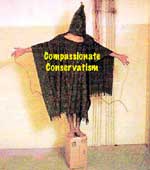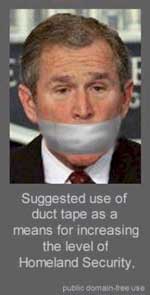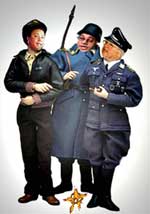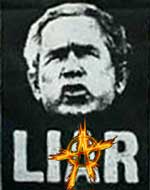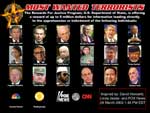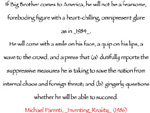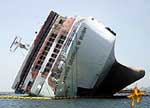The World Will End In Approximately [Input Error]
Anybody who knows me, is aware of my sense of humor, understands the [disclaimer], and my dislike for, what I consider to be, 'a corrupt political system', ... because (imo) everybody political has their hand in somebody else's 'special interest' pocket.
'Things' have reached a state critical enough where I feel compelled to comment and the preface would be, "Denial Is Not In Egypt."
pResident Bush appears to think he is above the rest of US and I assume this is because, for starters, he was never elected by the people, but that is not what frightens me.
What frightens me is, the Bush Administration and their Neocon bosses are guilty of war crimes and everyone in Congress and Senate between 2001 and 2003, with exception of Barbara Lee, as harsh as it may seem, is an accessory to murder.
Do you really believe [they] will admit their mistakes and accept their punishment? How far do you believe they will go in order to prevent jail terms? ... [Armageddon]? Speaking of mistakes, [here] is a short flash animation showing what pResident Bush says about them.
Lets face it, 'they' will not accept any responsibility for Iraq now that most everybody knows it was a Republican supported, Democrat backed lie. If there is any question about using the word "lie" watch this short flash animation by Haik Hoisington:
Lies, Lies, Lies - http://www.BlackMustache.com/lies.html
I will never forget the people of the World were behind pResident Bush after 9/11, but watch what happens in this animated [flash], which is an example of how truth fades into lie.
If you don't know by now, corporate media helped deliver the lie by (imo) an act of brainwashing induced through compulsive television watching. At one time 87% of the U.S. population believed Saddam had something to do with 9/11. Where did that come from?
Iraq had nothing to do with the mass murders of 9/11.
Attacking Iraq was a Neocon "plan" established before Bush was appointed by the [Supreme Court] ... and was nothing new. What do you think his Daddy's "NEW WORLD ORDER" was about?
Even the concept of "War on Terror" is a lie because it has never been technically declared a war by Congress [(imo) This is how the Bush Administration and evil Neocons will attempt to get around WAR CRIMES, torture, and other 'bad stuff'. Click [here] if you do not have a clue.]
The number of U.S. military killed since Bush's War began is reaching the number of people murdered during 9/11, and somewhere between 125,000 and 650,000 innocent Iraqi civilians have died. All because of Republican lies that were supported by a majority of inept Democrats.
It is an illegal war and we have heard "Stay the Course", which leads to another fear. pResident Bush said, "I Will Not Withdraw even If Laura And Barney Are The Only Ones Supporting Me."
Note: He puts his dog (Barney) above the wishes of the United States people and this is what caused me to research the symptoms of "Dry Drunk", which [Dahbud] stuck in my ear and [wrote] about (near the bottom of that page).
;-) Speaking of Dahbud, for years I have tolerated references to pResident Bush, Antichrists, and Ministers of Satan; however, if one were to ask me if I believed Bush could be one of the many alleged Antichrists five years ago, I would have laughed; however, today I believe there are possibilities, which leads to another fear and here is why.
Dahbud started this [observation] with help from [Balzac] and to be honest, 'on one hand' I thought it was humorous and on 'the other hand' I felt they would 'run into a wall' within the progressive activist community. (imo) Activists do not know how to deal with religion and few will take the time necessary to 'sort it out'.
About a year ago we were discussing some new evidence that showed (via an electron microscope) there were numerous erasures and rewrites on an ancient 'accepted" scroll that plays a major role in today's religion. [A more well known changing of religious history can be found in the accounts of Jewish historian [Josephus], whose text was obviously changed; and therefore, accepted by Rome.]
The conversation eventually led to [Revelations], [Antichrists], and Ministers of Satan.
We agreed Revelation could have been the result of [ergot poisoning], but when it came to pResident Bush being a possible Antichrist, I drew the line and said, 'If that were true, there would have to be more of a foundation of evil." [Other than:
The Antichrist:
is variously understood as being a consummately evil system of government or leader,
will be a leader who deceives many people,
will divide the world and create war without end,
will declare that things which are evil to be good,
will refer to war as peace, death as a solution for justice, and serving the wealthy as a means of helping the poor,
and that many nations will recognize that he is evil, but his own people will be inclined to believe his deceptions.
which would also appear to fit into a 'greater picture' of the present.]
The usual stuff was brought up about the Grandfather dealing with the Nazi Party, ties to oil, and so on, but the 'clincher' was tossed at me by Balz who said, "You are aware pResident's wife killed someone when she was a kid?"
"No I had not heard of that," I said, checked it out, and discovered it was [true]. Even more odd is, everyone I have asked about it, had not heard of it, and unfortunately, something like this, especially done in anger, would be an asset to that which would be Antichrist.
If I have lost you, here is another way of putting this. It would appear all the pieces for an Armageddon have always existed, sometimes people become what they despise, and it is possible, after making claims of talking to God, murdering all those Iraqi civilians, and getting caught in numerous lies, pResident Bush 'stepped into the available shoes', so to speak, of an Antichrist role, but (imo) not the main one.
(fwiw) Some of the old text suggests, 'there will be one to come before, who paves the way for the Beast'; very much like, in an opposite way, John the Baptist paved the way for Jesus (Role reversal at its peak in a realm of 'what comes around, goes around'.). In other words, Bush's actions may have opened a "Pandora's Box" to H E double hockey sticks [LL].
To summarize: 1) pResident Bush may start an Armageddon in order to Avoid Jail, 2) pResident Bush has control of "the button" and the ability to take US into War without question, thanks to a lame Congress, 3) It is possible pResident Bush may have serious psychological problems resulting from cocaine and alcohol abuse, and 4) He may have opened the doors to Hell on Earth or ..perhaps that was his intention?
The biggest disappointment is the attitude of the United States people because of their display of apathy rather than action. If this continues, I have been told, the [apology] may no longer be accepted.
In closing, I highly recommend watching / listening to this flash animation by Haik Hoisington (due to language, this piece is not 'work safe'):
Ride the Fence - http://www.BlackMustache.com/ride.html
~@~
NIST 9/11 REPORT EXPOSED!

Dead on Arrival
The NIST 9/11 Report On The World Trade
Center Collapse
By Mark H. Gaffney
12-15-6
http://rense.com/general74/nist.htm
Note to the reader: The following is a critique of the National Institute for Standards and Technology (NIST) report on the World Trade Center (WTC) collapse. The 43-volume NIST report was the result of a 3-year investigation, and was released in September 2005. It remains the official US government explanation for why the WTC collapsed on 9/11. As you are about to discover, the report itself collapses under scrutiny. There is no doubt that the NIST investigation was politically controlled by limiting its scope. This is one way to kill an investigation.
* * *
Fires raged at ground zero for many weeks after 9/11. In fact, it was not until December 19, 2001 that the NYC fire marshall declared the fires extinguished.
The fires burned long into the cleanup. The removal of steel beams and debris from the top of the pile allowed oxygen to reach the fires smoldering below. As a result, the flames often flared up, hampering worker on site. Joel Meyerowitz, a photographer, made note of this in his 2006 retrospective book, AFTERMATH. Armed with his trusty camera Meyerowitz roamed ground zero for months following the attack. Police repeatedly ejected him, but he kept returning in order to document what had happened. Eventually Meyerowitz amassed an impressive photographic record. In his fine book he remarks that the ground in places was so hot it melted the workmen's rubber boots.
But Meyerowitz was hardly the first to comment on the pile's incredible residual heat. The first accounts of molten steel came just hours after the attack: from the search and rescue teams who were among the first on the scene. Sarah Atlas, a member of New Jersey Task Force One Search and Rescue, was one of these emergency responders. Sarah reported seeing molten steel in the pile even as she searched in vain for survivors.[1]
Many have denied the existence of molten steel at ground zero. But there are too many eyewitness accounts to dismiss, including the testimony of engineers, city officials and other competent professionals who toured the ruin. One of these, Dr Keith Eaton, Chief Executive of the London-based Institution of Structural Engineers, later wrote in The Structural Engineer about what he had seen, namely: "molten metal which was still red-hot weeks after the event," as well as "four-inch thick steel plates sheered and bent in the disaster."[2]
A similar account came from Leslie E. Robertson, an engineer who helped design the WTC. He is currently a partner at Leslie E. Robertson Associates, a structural consulting firm that was under contract to the WTC at the time of the tragedy. In a keynote address Robertson reportedly told the Structural Engineers Association of Utah that: "...as of 21 days after the attack the fires were still burning and molten steel still running."[3] Public health officials/experts also toured the scene of destruction. Alison Geyh Ph.D., an Assistant Professor of Environmental Health at Johns Hopkins, was with one of these teams. She wrote that "In some pockets now being uncovered they are finding molten steel."[4] The fact was even reported to the 9/11 Commission by Kenneth Holden, Commissioner of the city of New York. He told the panel about seeing "molten metal" during a walkthrough.[5]
The evidence accumulated even as the cleanup progressed. Work crews removing the mountain of debris, piece by piece, discovered pools of molten steel beneath the pile, where the towers had stood. One pool was found at the bottom of the elevator shafts. Some of the pools were not found until 3, 4, even 5 weeks after 9/11.
Contractors working on site confirmed these discoveries. Such as Peter Tully, president of Tully Construction of Flushing New York, who was one of four contractors engaged by New York City to handle the cleanup. During an August 2002 interview Tully told the American Free Press that indeed workmen had seen the molten pools.[6] The same interview included a statement by Mark Loizeaux, president of Controlled Demolition, Inc., who, years before, ramrodded the cleanup of the bombed Federal Building in Oklahoma City. Loizeaux was called in by Tully to draft the cleanup plan for the WTC site. Loizeaux said, "Yes, hot spots of molten steel were seen in the basements." Molten steel was also found under WTC 7.
These pools of molten metal have never been explained. Loizeaux told the American Free Press that the continuing fires were fueled by "paper, carpet and other combustibles packed down the elevator shafts by the tower floors as they 'pancaked' into the basement." Manuel Garcia, a physicist, has suggested that cars left in parking garages under the WTC contained gasoline that may have fueled the fires.[7] Both are probably correct. But none of these fires were hot enough to melt steel. Indeed, none of the combustibles in the wreckage burned anywhere near the melting point of construction grade steel beams (2800 °F). As noted, the smoldering fires for the most part were oxygen-starved.
The persistence of molten steel under the WTC for many weeks is extraordinary---and anomalous. Evidently, the hot spots under the wreckage were not in the least fazed by heavy rain on September 12, nor by the millions of gallons of water that firemen and cleanup crews sprayed on the smoking ruins. Five days after the attack the US Geological Survey (USGS) found dozens of "hot spots" in the wreckage via remote sensing, i.e., an infrared spectrometer (AVIRIS). The two hottest spots were under WTC 2 and WTC 7. The USGS recorded surface temperatures as high as 1020°K (1376°F)).[8] The molten pools below the pile were at least twice that hot---- hot enough to evaporate the rain and water sprayed on the pile long before it ever reached the bottom.
The Official Reports
In its official report the 9/11 Commission never once mentions the molten pools ---despite the testimony of the New York city commissioner.
In its 43-volume report about the WTC collapse released in September 2005, the National Institute of Standards and Technology (NIST) does indeed mention the molten pools, but only in passing, to dismiss them. The NIST report not only fails to identify the energy source that melted steel beams and piers under the WTC, it states categorically that NIST inspectors found no evidence of any molten steel at ground zero---a dismissal that is directly contradicted by the eyewitness accounts of the emergency responders, engineers, officials, and health experts already cited, not to mention the lead contractors who accomplished the cleanup.[9] After brushing aside the issue as irrelevant to the WTC collapse, the NIST report then suggests that:
Under certain circumstances it is conceivable for some of the steel in the wreckage to have melted after the buildings collapsed. Any molten steel in the wreckage was more likely due to the high temperature resulting from long exposure to combustion within the pile than to short exposure to fires or explosions while the buildings were standing. [my emphasis] [10]
The NIST never clarifies what the "certain circumstances" might be that produced molten steel after the collapse. Its statement about "long exposure to combustion" is absurd on its face, given that there was no energy source in the pile of wreckage remotely capable of melting steel. In fact, the NIST's above statement is an affront to our intelligence, since the hot spots identified by the US Geological Survey immediately after 9/11 and the molten pools were surely one and the same. There is no way to avoid the conclusion that the molten materials under the wreckage, as well as the smoldering fires, were a residual product of whatever caused the collapse of the WTC. Something on September 11, 2001 burned hot enough to melt steel in the basement of both towers. But such a deduction is too simple, evidently, or too provocative for the NIST, which made a decision not to go there.
When asked about what caused the molten pools Peter Tully suggested that perhaps jet fuel was responsible. But on this point, at least, the NIST report is surely correct. It's easy to show that jet fuel was not the causative agent. There were reports that burning jet fuel leaked into the WTC elevators moments after the first impact. A descending fireball possibly caused explosions many floors below. Witnesses saw critically burned people emerging from elevators. Something ripped through the WTC 1 concourse lobby at about the time of the impact, blowing out windows and crumpling steel doors like they were paper. The same blast knocked marble slabs off the walls in the lobby. Custodians also heard explosions in the WTC 1 basement. A machine shop was wrecked, as well as a car garage.[11]
But as serious as these explosions and fires were, jet fuel simply does not burn with sufficient energy to melt steel---not even close. Many of the early reports by the US and world press erred in this respect. Indeed, in the emotional aftermath of the 9/11 attack the press often mangled the science as badly as the twisted steel beams of the WTC. One report posted by the BBC on September 13, 2001 quoted experts who stated matter-of-factly that the burning jet fuel actually melted the central columns, leading to the collapse.[12] Another report on The History Channel, The Anatomy of September 11th, claimed that the inferno turned the steel piers in in the WTC to "licorice." A 2002 PBS NOVA special "Why the Towers Fell" showcased a similar theory, and suggested that the fires reached 2000°F, which caused the steel columns to lose 80% of their strength.[13]
Even trained professionals jumped on the bandwagon---and got it wrong. The day after the attack the Sunday Times interviewed Hyman Brown, a civil engineering professor at the University of Colorado: "Steel melts," Brown said, "90,850 liters of aviation fluid melted the steel. Nothing is designed....to withstand that fire." Years before, Brown had been involved in the construction of the WTC as a project engineer.[14] (He was later shown to be wrong about the amount of jet fuel. The NIST determined that the planes actually carried no more than 10,000 gallons---about 40,000 liters).
The same day NewScientist.com asserted that "raging fires melted the supporting steel struts."[15] On September 13, 2001 BBC radio interviewed Chris Wise, an engineer who explained that...
"It was the fire that killed the buildings. There's nothing on earth that could survive those temperatures with that amount of fuel burning. The columns would have melted, the floors would have melted, and eventually they would have collapsed one on top of the other."[16]
Elmer Obermeyer, the president of an Ohio engineering firm, also endorsed the meltdown theory in a story in the Cincinnati Business Courier. The paper noted that Obermeyer was a "guru in his field."[17] In October 2001 Scientific American.com posted an article summarizing the results of a 9/11 panel of MIT experts, one of whom, Eduardo Kausel, stated "that the intense heat softened or melted the structural elements--floor trusses and columns--so that they became like chewing gum, and that was enough to trigger the collapse.[18]
This is but a small sampling of many such reports that appeared in those first days. All of them were wrong. As Frank Gayle, one of the NIST's lead scientists, later pointed out: "Your gut reaction would be [that] the jet fuel is what made the [WTC] fire so very intense. A lot of people figured that's what melted the steel. Indeed, it did not, the steel did not melt."[19] Gayle was seconded by Thomas Eagar, a professor of materials engineering at MIT:
"The Fire is the most misunderstood part of the WTC collapse. Even today the media report (and many scientists believe) that the steel melted. It is argued that the jet fuel burns very hot, especially with so much fuel present. This is not true....The temperatures of the fire at the WTC were not unusual, and it was most definitely not capable of melting steel."[20]
When trained professionals get it wrong we should not be surprised by the mistakes of journalists, few of whom are trained in physics. The fact is that jet fuel, which is essentially kerosene, will not burn in air in excess of about 1,000°C (1,832°F)---nowhere near the 2,800°F melting point of steel. Even this 1,000°C upper limit is very difficult to achieve, since, as Thomas Eagar pointed out, it requires the optimal mixing of fuel with oxygen during combustion, which can only be achieved in a laboratory. In fact, the clouds of black smoke that poured out of the twin towers on 9/11 were an obvious sign that the WTC fire burned at much lower temperatures, probably around 650°C (1,202°F) range, or even lower. This was due to the inefficient mixing of oxygen. It's why most building fires burn no hotter than around 500-650°C. (932 -1,202°F)
To date, no one, including the NIST, has identified an energy source in the WTC---or in the Boeing 767s---capable of melting steel.
The NIST Report
Since the primary stated objective of the NIST 9/11 investigation was to determine the cause of the WTC collapse, the NIST should have conducted a forensic examination of the full spectrum of evidence.[21] Ground zero was a crime scene, was it not? Yes, and because many credible eyewitnesses, including firemen who were on duty that fateful day, reported that they heard and/or saw explosions, the NIST should have investigated this without bias.[22] It should have viewed this testimony as hard evidence: a starting point in its investigation. Instead, the NIST did a gloss. It posted a statement on its web site asserting that it had considered a number of hypotheses, including a planned demolition, but had found no corroborating evidence.[23] This disclaimer was no more than a last-minute attempt to deflect criticism, since a close reading of the NIST report shows that the agency never entertained other alternatives. It certainly never investigated the eyewitness accounts of explosions.
The NIST report assumes, start to finish, that the Boeing 767s were responsible for the collapse of the twin towers. The agency took it for granted that the impacts set in motion a chain of events leading to catastrophic structural failure. The assumption is even stated explicitly in the Executive Summary:
The tragic consequences of the September 11, 2001 attacks were directly attributable to the fact that terrorists flew large jet-fuel laden commercial airliners into the WTC towers. Buildings for use by the general population are not designed to withstand attacks of such severity; building codes do not require building designs to consider aircraft impact.[24]
The 43 volume NIST report confines itself to the sequence of events from the first plane impacts to the onset of collapse; and is governed throughout by ipso facto reasoning. Because the agency never entertained the possibility of a planned demolition, it never bothered to look for evidence of same. For example, it never tested steel samples recovered from ground zero for telltale traces of explosives. These omissions were irresponsible and smack of political interference, since in addition to the eyewitness accounts two scientific papers, one published in 2001, and another by FEMA in May 2002, had already detected sulfur residues on samples of WTC steel.[25] As Dr. Steven Jones, a physics professor at BYU, has pointed out, sulfidation of steel can be an indicator of the use of thermate (or other closely related compounds) developed by the military and commonly used to cut steel in demolitions work.[26] The possibility needed to be checked, if only to rule it out; but the agency, again, chose not to go there.
Let us now examine the NIST report in detail.
Why the WTC Survived the 767 Impacts
Everyone, including the NIST, agrees that the twin towers survived the initial Boeing 767 impacts on September 11, 2001---despite serious damage. The buildings survived because the WTC was hugely overbuilt: redundant by design. The towers simply transferred the load from the severed/damaged members to other undamaged columns.
Upon its completion in 1970 the World Trade Center was not only the world's tallest twin-skyscraper (1,368 feet), it was also a state-of-the-art achievement of modern construction.[27] Although the WTC's soaring lines gave the impression of a relatively light frame, in fact, the towers were extremely rugged, engineered to withstand hurricane-force winds and to survive a direct hit by a Boeing 707, the largest commercial jetliner of the day. In a 1993 interview the WTC's principal structural engineer, John Skilling, stated that prior to construction he performed an impact analysis of a 600 mph Boeing 707 impact, and concluded "that the building structure would still be there."[28] The architectural firm that worked with Skilling described his 1,200 page structural analysis as "the most complete and detailed ever made for any building structure."[29] Frank A. Demartini, onsite manager during the construction of the WTC, seconded this view during a January 25, 2001 interview, in which he noted that the study involved "a fully loaded 707." Demartini even declared that "the building probably could sustain multiple impacts of jetliners because this structure is like the mosquito netting on your screen door, this intense grid, and the jet plane is just a pencil puncturing that screen netting."[30] Demartini kept an office in the North Tower and was last seen on 9/11 assisting evacuees on the 78th floor.[31]
The original WTC design, the work of architect Minoru Yamasaki, was one of the first architectural plans to call for open space within a steel-frame building. This meant doing away with the forest of columns so typical of the steel high-rise buildings of former years. Chief engineer Skilling achieved the objective with a double support system: a dense array of 236 columns around the perimeter, and a network of 47 massive piers at the core. The creation of large expanses of unobstructed floor space within the WTC was a novel idea in the 1960s, but is commonplace today.[32]
The weight of each building was distributed about equally between the two sets of columns. The outer wall shielded the building from high winds, and was reinforced with broad steel plates known as "spandrels," which girdled the building, like ribs, at every floor. The core contained the elevators, stairwells, and utility shafts. Both sets of columns were joined together by an innovative system of lightweight steel trusses. Each story was supported by a truss assembly covered with a corrugated steel deck---the bed for a poured slab of lightweight concrete. Probably Skilling's greatest innovation was to extend the truss diagonals up into the concrete floor, which added stiffness and strength. Each truss assembly/concrete floor behaved as a single unit.
Prefabrication and the overall modular design were other innovations that allowed for speedy construction---and kept costs down. The advent of new high-strength steels made it all possible. In fact, the WTC had tremendous reserve capacity. An early article about the project in the Engineering News-Record declared that "live loads on these [perimeter] columns can be increased more than 2,000 percent before failure occurs."[33]
After a three-year investigation the NIST concluded that the World Trade Center would have survived on 9/11 if the impacts had not dislodged the buildings' protective fireproofing---installed at the time of construction to protect the steel columns from fire-generated heat. Construction-grade steel begins to lose its tensile strength at 425°C (~800°F), and is only about half as strong at 650°C (1,202°F). The lightweight truss assemblies were especially vulnerable, since they consisted of rather thin steel members. During construction they were coated with spray-applied insulation. The much larger steel piers and columns had a fire-barrier of gypsum wallboard.
NIST's Official Explanation
The NIST concluded that the impact of the jetliners damaged or dislodged 100% of the protective insulation within the impact zone, while also spilling many thousands of gallons of jet fuel over multiple floors. The resulting 800-1,000°C (1,440-1,800°F ) blaze seriously weakened the now-exposed steel trusses. The trusses and floors sagged---they argued---which pulled the perimeter columns inward, causing them to buckle. The fires also weakened the central piers. The combination of these effects destabilized the structures and at a critical point the towers simply collapsed. The NIST concluded that the WTC would have survived the fires if the Boeing 767 impacts had not dislodged/damaged the fireproofing material, which, therefore, according to the NIST, was the critical factor on 9/11.
There are a number of serious problems, however, with this official narrative. In the first place, it is sharply at odds with the video record, which plainly shows that during each collapse perimeter columns and other structural members didn't simply fall to the ground. In many cases they were ejected up and out of the disintegrating structure at nearly a 45 degree angle: a cascade that hurled steel beams weighing 20 tons or more as much as 600 feet from the base of the buildings. One remarkable photo of ground zero taken from above shows that entire sections of WTC 1's western perimeter wall were thrown 500+ feet toward the Winter Garden.[34] Could a gravitational collapse do this?
Pulverization
Photos of the mountain of wreckage taken by Joel Meyerowitz and others also show very few, if any, large chunks of concrete. The rubble pile almost exclusively consisted of twisted steel beams, pipes, aluminum, etc. Concrete was conspicuous in its absence. This is remarkable when you consider that the 500,000 ton towers were made up largely of concrete. Each floor of the 110-story WTC, roughly one acre in size, consisted of a 4-inch thick slab of poured concrete on a deck of 22-gauge steel. During the collapse something---some force---pulverized nearly all of this concrete into fine dust. Many have attributed this to the brute hammer of gravity, but the videos clearly dispute this. The buildings weren't pulverized as they hit the ground, but rather, in midair as the buildings disintegrated. Much of the dust settled a foot or more deep on the 16-acre WTC site. The rest was deposited across lower Manhattan. Nor was this pulverization limited to concrete. Many other materials also disappeared without a trace on 9/11; such as office furniture and thousands of computers, not to mention the many victims who died in the collapse. It's a fact that less than 300 corpses were recovered in the wreckage. Yet, strangely, many months later, during the demolition of the Deutsch Bank---badly damaged in the 9/11 attack---workers found more than 700 body parts, e.g., slivers of bone, on the roof and within the doomed structure.[35] The question is: why? This bizarre report remains a mystery.
The videos of the collapse also reveal another anomaly, one that I find personally disturbing. The towers did not pancake in the usual fashion of concrete buildings. When large buildings drop during powerful earthquakes each story tends to fall more or less intact upon the floors beneath. The building itself serves to brake the fall from above. Photographs taken after earthquakes typically show a succession of concrete slabs piled one on top of another, each plainly discernible in the rubble. But nothing like this happened on 9/11. The collapse of WTC 1 and WTC 2 were nearly a free-fall. If the towers had pancaked from above the inertial mass of the lower floors would have resisted and slowed the fall considerably---even arrested it. But this didn't happen. The towers plummeted as if there were no resistance whatsoever. From start to finish they fell in only about 12 seconds, just 2 seconds longer than the time for a billiard ball to drop from the WTC roof to the plaza below. The question is why?
The NIST report failed to address any of these anomalies. In fact, it didn't even try. The NIST sidestepped the ejection of material, the vast pulverization of concrete, the many testimonials and other evidence of explosions, and the near-free fall by limiting its investigation to the sequence of events from the Boeing 767 impacts to the onset of the collapse. Incredibly, the NIST chose not to examine the collapse itself. The report makes reference to the "global collapse" of the WTC, but we never learn what this means because the NIST report never tells us. Once again, the agency decided not to go there. Evidently we are supposed to assume that gravity alone was responsible. But could gravity transform enormous slabs of concrete, hundreds of thousands of tons of material, into fine dust, in midair? Extremely doubtful. The NIST's decision not to investigate these important questions add up to more grave omissions.
But we haven't yet examined the NIST report itself. Let's do that, now.
The Special Projects
The NIST investigation incorporated eight separate projects, all of which, together, produced 42 volumes of supporting documentation; all told, some 10,000 pages. The projects included an impact analysis, metallurgical studies, a reconstruction of the fires, and a computer model of the probable sequence of events leading up to collapse of each tower. Some of the agency's investigative work was of excellent quality---some wasn't---but very little of it lends credence to the NIST's final, and official, explanation of the cause of the WTC collapse.
One of the most serious and persistent problems NIST investigators faced was the admitted lack of information about conditions at the core of the towers.[36] To be sure, thousands of photographs and hundreds of hours of videotape made it possible to study in detail the damage to the WTC exterior, and to gain a reasonable understanding about conditions in the outer offices. Fires were often visible through the windows, despite dense smoke, and sagging floors and other structural damage was discernible through gaping holes in the damaged exterior. However, as the NIST report states, "Fires deeper than a few meters inside the building could not be seen because of the smoke obscuration [sic] and the steep viewing angle of nearly all the photographs."[37] Thus, except for steel samples gathered after the fact the NIST had almost no other information about the dynamic conditions at the core of the WTC on 9/11.[38]
The agency sought to overcome this shortfall of information with computer simulations. This was problematic from the outset, since computer models are no better than the quality of input and the accuracy of the programmer's assumptions. As architect and critic Eric Douglas points out in his 2006 analysis of the NIST report: "a fundamental problem with....computer simulation is the overwhelming temptation to manipulate the input data until one achieves the desired results."[39] Did the NIST investigators fall prey to this insidious tendency? And did this lead them to overestimate the impact damage to the WTC interior? Let us now consider this question.
NIST's Global Impact/Collapse Analyses
In one of its most important projects (NCSTAR 1-2), NIST scientists developed a global impact analysis: to estimate the structural damage to the WTC caused by the Boeing 767s. In this study the NIST considered three different scenarios. These ranged from less damage to extreme damage, with a moderate alternative (described as "the base") in the middle. As it happened, all three scenarios accurately predicted the impact damage to the WTC exterior at the point of entry; although with regard to WTC 1 the moderate case was a slightly better match.[40] The three differed greatly, however, in predicting the number of severed columns at the WTC core, a datum obviously of great importance. In the case of WTC 1 the lesser alternative predicted only one severed core column, the moderate alternative predicted three, while the extreme alternative predicted five to six. In the case of WTC 2 the disparity was even greater: The lesser alternative predicted three severed columns, the moderate five, and the extreme case no less than ten.[41]
Although the NIST never satisfactorily resolved these differences, it immediately threw out the less severe alternatives, citing two reasons in the Executive Summary report: first, because they failed to predict observable damage to the far exterior walls; and second, because they did not lead to a global collapse.[42]
On 9/11 the first tower sustained visible damage to its opposite. i.e., south wall, caused by an errant landing gear and by a piece of the fuselage, which were later recovered from below. Also, at the time of the second impact a jet engine was seen exiting WTC 2's opposite wall at high speed, after passing through the building. It was later found on Murray Street, several blocks northeast of the WTC. In its summary report the NIST leads us to believe that it used the observable damage to the far walls caused by these ejected jet plane parts to validate its simulations. Yet, in one of its supplementary documents the NIST admits that "because of [computer] model size constraints, the panels on the south side of WTC 1 were modeled with a coarse resolution...[and for this reason] The model....underestimates the damage to the tower on this face."[43] But---notice---this means that none of the alternatives accurately predicted the exit damage.[44]
This admission, deeply buried in the 43 volume report, is fatal to the NIST's first rationale for rejecting the lesser alternative, since it was no less accurate than the moderate and extreme cases. (Or, put differently: It was no more inaccurate.) Which, of course, means that the NIST rejected the lesser alternative for only one reason: because it failed to predict a global collapse. The simulations for WTC 2 suffered from the same modeling defect. As the supplementary documentation states, "None of the three WTC 2 global impact simulations resulted in a large engine fragment exiting the tower."[45] Yet, here again, the NIST rejected the lesser alternative. We can thank researcher Eric Douglas for digging deeper than the summary report. Otherwise, this flaw, tantamount to the devil lurking in the fine print, might never have come to light.
But biased reasoning did not deter the NIST. Later, it also tossed out the moderate (base) alternatives, ultimately adopting the most extreme scenarios in its subsequent global collapse analysis---even though, as noted, the moderate alternatives were no less accurate, from a predictive standpoint, than the extreme cases. In fact, with regard to predicting the entry damage to WTC 1, as noted, the moderate alternative was actually a better match.
The NIST report offers no scientific rationale for this decision, only the pithy comment that the moderate alternatives "were discarded after the structural response analysis of major subsystems were compared with observed events."[46] And what, pray tell, were these "observed events"? The report explains that "structural models....indicated that....the buildings would have continued to stand indefinitely."[47] Here, at least, the NIST is more forthright than in the case of the lesser alternatives.
Things only get worse.
As it happened, even the extreme alternatives required further tinkering to be acceptable. The report informs us that "Complete sets of simulations were then performed for cases B and D [the extreme alternatives]. To the extent that the simulations deviated from the photographic evidence or eyewitness reports, the investigators adjusted the input, but only within the range of physical reality."[my emphasis][48] In other words, NIST scientists worked backwards from the collapse, tweaking the extreme alternatives until their computer model finally spat out the desired result consistent with their assumption, which never wavered, that the 767 impacts ultimately were at the root of everything on 9/11. Of course, the NIST report never tells us what the "additional inputs" were.
That the NIST's impact study and subsequent global collapse analysis were biased, hence, unscientific, ought to be obvious. But I will go even further: The impact simulations were very nearly a waste of time, since by its own admission the NIST had almost no information about actual conditions at the WTC core. The NIST had no sound basis for rejecting the lesser and moderate impact alternatives; both were at least as plausible as the extreme alternative. Why were they not given equal weight? The reason is obvious: That would have compelled NIST investigators to entertain the unthinkable, i.e., the possibility that some other causative agent was responsible for the WTC collapse. Still, one has to admire, in a perverse sort of way, the NIST's triumph of circular reasoning..
The Metallurgical Studies
The NIST's metallurgical and fire studies were among the most important projects, and involved testing 236 samples of steel columns, panels, trusses, and other smaller parts recovered from ground zero. Thanks to the original labeling system used during the construction of the WTC, the NIST was able in many cases to identify individual steel members, and thus to determine their exact locations in the WTC. As it happened, some of the samples were from the impact zones and fire-damaged areas.[49] The collection represented only 0.25 - 0.5 % of the 200,000 total tons of structural steel used the two towers. But the NIST believed it had enough samples to determine the quality of the steel and evaluate its performance on 9/11.[50]
The NIST's findings decisively refuted the pancake theory of collapse that had been widely reported in the media. According to this theory the WTC collapse on 9/11 was due to failure of the WTC truss assemblies. A number of vocal experts had claimed that the weak link was the point of attachment: where the trusses connected with the inner and outer columns. These junctions, often referred to as angle-clips, were made of relatively lightweight steel and were secured by steel bolts. During a 2002 NOVA special---before the NIST ran its metallurgical/fire tests---Thomas Eagar, the MIT engineer already cited, summed up the view of many about how and why the trusses failed on 9/11:
"...the steel had plenty of strength, until it reached temperatures of 1,100º to 1,300ºF. In this range, the steel started losing a lot of strength, and the bending became greater. Eventually the steel lost 80 percent of its strength, because of this fire that consumed the whole floor....then you got this domino effect. Once you started to get angle-clips to fail in one area, it put extra load on other angle-clips, and then it unzipped around the building on that floor in a matter of seconds. If you look at the whole structure, they are the smallest piece of steel. As everything begins to distort, the smallest piece is going to become the weak link in the chain. They were plenty strong for holding up one truss, but when you lost several trusses, the trusses adjacent to those had to hold two or three times what they were expected to hold."[51]
Eagar's collapse model sounded plausible enough---but the NIST investigation didn't bear it out.
Because the NIST did not have the necessary facilities, it contracted Underwriter Laboratories to conduct a series of fire endurance tests on trusses like those in the WTC. (The recovered truss samples were too badly deformed during the collapse to test them directly, so NIST fabricated new trusses identical in design.) The purpose of the tests was to establish a baseline, and the results were surprising. Not one of the truss assemblies failed during a series of four tests, not even the truss sprayed with the minimum amount of fireproofing. "The floors continued to support the full design load without collapse for over two hours."[52] The investigative team cautiously noted that the exposure of the floor systems to fire on 9/11 was "substantially different" than the conditions in the test furnaces, which was true enough. Yet, the team noted that "this type of assembly was capable of sustaining a large gravity load without collapsing for a substantial period of time relative to the duration of the fires in any given location on September 11."[53] The UL tests not only laid to rest the theory that the trusses were the cause of the collapse on 9/11, if anything, the tests demonstrated the fundamental soundness of the WTC truss design.
Another finding: The WTC steel turned out to be significantly stronger than expected. Tests showed that the yield strengths of 87% of the perimeter/core columns, and all of the floor trusses samples, exceeded the original specifications by as much as 20%. "The yield strengths of many of the steels in the floor trusses were above 50 ksi, even when specifications required 36 ksi."[54] (1 ksi = 1,000 lb/per square inch) The NIST performed similar tests on a number of recovered bolts, and found that these too were "much stronger than expected, based on reports from the contemporaneous literature."[55] Notice---none of these findings support the NIST's official explanation for the WTC collapse. On the contrary.
The Fire Tests:
Core Weakening?
Another series of tests sought to address the alleged weakening of the WTC support columns. During a first-run investigators placed an uninsulated steel column in a 2,012ºF (1,100ºC) furnace and measured the rise in its surface temperature. Notice, this laboratory furnace was significantly hotter than the fires on 9/11 caused by jet fuel or any other combustible in the WTC. The column reached 600ºC in just 13 minutes---the temperature range where significant loss of strength occurs. When the test was repeated again with an insulated column, the steel did not reach 600ºC even after ten hours. The NIST concluded that "the fires in WTC 1 and WTC 2 would not be able to significantly weaken the insulated....columns within the 102 minutes and 56 minutes, respectively, after impact and prior to collapse."[my emphasis][56]
The NIST interpreted these results as validating its favored hypothesis that the critical factor on 9/11 leading to the global failure of the WTC's support columns was the damage to the fireproofing insulation caused by the Boeing 767 impacts. But was this an unwarranted leap? It certainly was not supported by the NIST's metallurgical analyses, which showed that not even one of the 236 steel samples, including those from the impact areas and fire-damaged floors, showed evidence of exposure to temperatures in excess of 1,110ºF (600ºC) for as long as 15 minutes.[57] In fact, out of more than 170 areas examined on 16 recovered perimeter columns, only 3 reached temperatures in excess of 250ºC (450ºF) during the fires.[58] And why ? Well, perhaps, in part, because, as Shyam Sunder, the lead NIST investigator, admitted, "the jet fuel....burned out in less than ten minutes."[59] Also, NIST scientists made another surprising discovery: The actual amount of combustibles on a typical floor of the WTC turned out to be less than expected, only about 4 lbs./sq. foot. Furthermore, "the fuel loading in the core areas....was negligible."[60] The shocking fact is that the World Trade Center was fuel-poor, compared with most other buildings. The NIST estimated that a fire in a typical area of the building would have burned through the available combustibles at maximum temperatures (1,000ºC) in about 15-20 minutes.[61] Not nearly long enough even at that temperature to cause exposed steel to lose 80% of its strength.
Nor is this all. I searched the NIST report in vain for any acknowledgment that here, as in the case of the truss assembly test, the actual fire conditions on 9/11 were substantially different from the UL laboratory furnace. In fact, with respect to the columns the differences were at least as significant as with the truss assembly test, and call into sharp question the NIST's conclusion that damaged insulation was the critical factor. Although the NIST took the position that "temperatures and stresses were high in the core area,"[62] as I've noted the investigation suffered from a persistent lack of information about real conditions at the core. The NIST had no hard evidence about the actual amount of protective insulation damaged/dislodged during the impacts. The NIST report acknowledges this,[63] then goes on to assume that all structural members in the debris path at the time of impact suffered 100% loss of insulation.[64] Surely, we are safe to conclude that the Boeing 767 impacts did cause damage to, or strip away, a substantial portion of the fireproofing material. Exactly how much is not knowable. But even if the NIST estimate of total loss of fireproofing is correct, there is virtually no chance that the fires on 9/11 weakened the WTC's core piers within the allotted span of time: 56/103 minutes.
A Vast Heat Sink
The reason for this, nowhere acknowledged in the NIST report, ought to be obvious: The WTC's support columns did not exist in isolation. This was no laboratory furnace. The columns in each tower were part of an interconnected steel framework that weighed at least 100,000 tons; and because steel is known to be an excellent conductor of heat this massive steel superstructure functioned on 9/11 as an enormous energy sink. The total volume of the steel framework was vast compared with the relatively small area of exposed steel, and would have wicked away the fire-caused heat almost as quickly as it was generated. Anyone who has repaired a copper water pipe with a propane torch is familiar with the principle. One must sit and wait patiently for the pipe temperature to rise to the point where the copper finally sucks the solder into the fitting. While it is true that copper is more conductive than steel, the analogy holds, regardless. The fact that only three recovered steel samples showed exposure to temperatures above 250ºC indicates that the steel superstructure was indeed behaving as a heat sink. The fires on 9/11 would have taken many hours, in any event, much longer than the brief allotted span of 56/103 minutes respectively, to slowly raise the temperature of the steel framework as a whole to the point of weakening the exposed members.
And there are other problems. Since in a global collapse all of the columns by definition must fail at once, this implies a more or less constant blaze across a wide area. But this was not the case on 9/11. As already noted, the NIST's lead investigator, Shyam Sunder, admitted that the jet fuel was consumed within minutes. Also, the NIST found that the unexpectedly light combustibles in any given area of the WTC were mostly consumed in about 15-20 minutes. At no point on 9/11 did the fires rage through an entire floor of the WTC at the same time---as Thomas Eagar implied in his interview. The fires in WTC 1 were transient.[65] They flared up in a given area, reached a maximum intensity within about 10 minutes, then gradually died down as the fire front moved on to consume combustibles in other areas. But notice what this means: As the fires moved away from the impact zone to areas with little or no damage to the fireproofing, the heating of the steel columns and trusses in those areas would have been negligible. The NIST's own data showed that, overall, the fires on floor 96---where the collapse began---reached a peak 30-45 minutes after the impact and waned thereafter. Temperatures were actually cooling across most of floor 96, including the core, at the moment of the collapse. But if this is true, the central piers were not losing strength at that point but regaining it.[66] How, then, did they collapse? Finally, the NIST's insistence that "temperatures and stresses were high in the core area" is not consistent with their finding that the fuel load of combustibles in the core was negligible.[67] On this point the NIST contradicts itself.
In short, the NIST report fails to explain how transient fires weakened WTC 1's enormous central piers in the allotted span of 103 minutes and triggered a global collapse.
The Fires in the Second Tower
The NIST concluded that in WTC 2 the fire behavior was substantially different: more continuous (rather than transient), especially on the east side of the building where the impacting Flight 175 allegedly piled up combustibles. This---we are informed---in addition to more extensive impact damage of the core columns, helps to explain why WTC 2 fell first, even though it was impacted after WTC 1. Videos filmed on 9/11 do show inward bowing of WTC 2's eastern wall, although its actual extent and significance remain disputed. But perhaps the most serious challenge to the official view that fires were gravely weakening WTC 2 comes from an audiotape released in August 2002 by the Port Authority of New York. The tape, which was lost or neglected for more than a year, is the only known recording of firefighters inside the towers. When city fire officials belatedly listened to it they were surprised to discover that firemen actually reached the impact/fire zone of WTC 2 about 14 minutes before the building collapsed. On climbing to the 78th floor sky lobby Battalion Chief Orlo J. Palmer and Fire Marshall Ronald P. Bucca found many dead or seriously injured people, but no raging inferno. The audio transmission between Palmer and another fireman shows no hint of panic or fear, as the following transcript shows:
Battalion Seven Chief: "Battalion Seven ... Ladder 15, we've got two isolated pockets of fire. We should be able to knock it down with two lines. Radio that, 78th floor numerous 10-45 Code Ones.
Ladder 15: "Chief, what stair you in?"
Battalion Seven Chief: "South stairway Adam, South Tower."
Ladder 15: "Floor 78?"
Battalion Seven Chief: "Ten-four, numerous civilians, we gonna need two engines up here."
Battalion Seven Chief: "Tower one. Battalion Seven to Ladder 15."
Battalion Seven Chief: "I'm going to need two of your firefighters Adam stairway to knock down two fires. We have a house line stretched we could use some water on it, knock it down, okay."
Ladder 15: "Alright ten-four, we're coming up the stairs. We're on 77 now in the B stair, I'll be right to you."
Battalion Seven Operations Tower One: "Battalion Seven Operations Tower One to Battalion Nine, need you on floor above 79. We have access stairs going up to 79, kay."
Battalion Nine: "Alright, I'm on my way up, Orio."[68]
Here, Battalion Chief Orlo Palmer calls for hoses to be brought up to put out the fires. His expression "10-45 Code Ones" is a reference to dead bodies, of which, evidently, there were many. The tape shows that the firemen were not turned back by heat, smoke, or a wall of flames. They were able to function within the impact zone and were prepared to help the injured and combat the small fires they found. Palmer even mentions that the stairwell up to the next floor, i.e., 79, was passable. Minutes later the building came down on their heads.
Inexplicably, the NIST never considered this important evidence. The question is why? Their omission is especially damning, since, as I've stressed, the NIST investigation suffered from a persistent lack of information about actual conditions at the core.[69] Here was real-time testimony from firefighters who were on the scene, and the NIST simply ignored it.
Of course, it's possible that more intense fires were raging several floors above the two brave firemen---fires that did cause fatal weakening of columns. This is possible, but the available evidence does not support it. Among the steel samples recovered by NIST investigators were two core columns (C-88a and C-88b) from higher up in the impact zone. Actually, these were two different pieces from the same column (801). The NIST pinpointed their location on floors 80 and 81, several floors above the firemen---very near but just outside the path of Flight 175. Both samples were physically damaged, but the NIST reported no evidence of the kinds of distortion, i.e., bowing, slumping, or sagging that are typical of heat-weakened steel. Nor was the NIST able to glean any evidence of high temperatures from the columns.[70] On what, then, do they base their conclusion that "Dire structural changes were occurring in the building interior"?[71] If anything, the paucity of evidence calls into question the NIST's declaration that their sampling effort was adequate.
Moreover, as we've already noted, the NIST's computer simulation predicting extreme damage to the core of WTC 2 is dubious, since it is also unsupported by hard evidence. In fact, the NIST's preferred extreme alternative was, from a predictive standpoint, no better than the lesser alternatives, which the NIST rejected. Even the extreme alternative failed to predict a global collapse, without "additional inputs." As for the inputs, it would be interesting to know more about them. Unfortunately, the NIST's global collapse analysis is so highly technical as to be almost incomprehensible to a non programmer. I was struck by the number of assumptions it makes, one piled on another.
The Issue of Reserve Capacity
In order to show just how weak the official 9/11 narrative is, let us assume, for the sake of argument, that local fires did burn long and hot enough to weaken exposed columns in the impact zone of WTC 2. As I will now show, even if this did occur it still fails to account for the global collapse of the second tower. As the NIST report states,
both towers had considerable reserve capacity. This was confirmed by analysis of the post-impact vibration of WTC 2, the more severely damaged building, where the damaged tower oscillated at a period nearly equal to the first mode period calculated for the undamaged structure.[my emphasis][72]
The data showed that WTC 2, the more seriously damaged tower, gave no hint of instability after the initial impact. Unfortunately, although the NIST summary report provides a wealth of information it fails to clarify this important matter of the WTC's "considerable reserve capacity." I scoured the full summary report, as well as the preliminary 2004 report---in vain---for any discussion of the issue. I then called the NIST for assistance and was guided to several of the project reports and supplementary documents. I also consulted with experts at the International Code Council (ICC) and with a leading structural engineer. I learned that estimating the overall reserve capacity of a steel structure is no simple task. Numerous factors are involved. Moreover, there are different ways to approach the problem.
Perhaps the simplest measure of reserve capacity are the standards for the material components of a building. In the late 1960s when the WTC was constructed the applicable standard was the New York City Building Code, which required a builder to execute computations for the various structural members to show that they met the specified requirements. However, the code also allowed for actual testing of members, in the event that computations were impractical. The testing standards applicable in 1968 give a good idea of the required level of reserve strength in the steel columns and other materials used in the WTC. For example, in the most stringent test a steel member had to withstand 250% of the design load, plus half again its own weight, for a period of a week, without collapse.[73]
Factor of Safety
Another widely used measure of reserve capacity is the so called "factor of safety." This varies for different structural elements, but for steel columns and beams typically ranges from 1.75-2.0.[74] The NIST report actually breaks this more general figure down into two separate and slightly different measurements for stress: yielding strength (1.67) and buckling (1.92).[75] For our purposes, however, the more general figure is adequate. So, for example, a steel column with a factor of safety of 1.75 must support 1.75 times the anticipated design load before it begins to incur damage. While this value is typical of steel beams in general, the actual reserve strength of the steel columns in the WTC was higher. When the NIST crunched the numbers for the 47 core columns of WTC 1 (between the 93rd and 98th floors) it found that the factor of safety ranged from 1.6 to 2.8, the average value being 2.1.[76] This means that the average core column in WTC 1 could support more than twice its design load before reaching the yield strength, i.e., the point where damage may begin to occur.
Notice, the factor of safety is not a threshold for collapse, but a value beyond which permanent damage may occur. As the NIST report states, even "after reaching the yield strength, structural steel components continue to possess considerable reserve capacity."[77] This is why steel beams and columns do not typically fail in sudden fashion. The loss of strength is gradual. No doubt, this helps to explain why, although fires have ravaged many steel frame buildings over history, not a one had ever collapsed---until 9/11---nor has any since. So we see---it should be obvious---that even in the highly improbable worst case, in which many of the WTC columns lost half of their strength, there was still plenty of reserve capacity to support the building.
The Perimeter Wall
With regard to the WTC's perimeter columns, the factor of safety varied from day to day and even from hour to hour, because, in addition to supporting about half of the WTC's gravity load, the perimeter wall had to withstand the force of wind---which is highly variable given the whims of Mother Nature. A single face of the WTC presented an enormous "sail" to the elements, which is why John Shilling vastly overbuilt this part of the structure. According to the NIST report, the wall's factor of safety against wind shear on 9/11 was extremely high, i.e., 10-11.[78] Why so high? The reason is simple: On the day of the attack there was almost no wind.[79] As a result, nearly all of the perimeter wall's design capacity was available to help support the gravity load. As the NIST report states, "On September 11, 2001 the wind loads were minimal, thus providing significantly more reserve for the exterior walls."[80] Of course, because wind is mostly a lateral force the additional capacity that was available to help support the gravity load was less than one-to-one. When the NIST crunched the numbers for a representative perimeter column in WTC 1 (column 151 -- between the 93rd and 98th floors), they arrived at a factor of safety of 5.7.[81] If we take this average figure as a typical value we arrive at an accurate estimate of the perimeter wall's amazing reserve strength. Even if we subtract the columns severed/damaged by the impact of Flight 175, and the lost capacity due to buckling along one perimeter wall, there was still a wide margin of safety---more than enough by several times over to support half of the structure's gravity load, which overall did not change. Of course, the wrecked jetliner added substantial mass. On the other hand, due to the successful evacuation of people the live load, i.e., the total body mass of the occupants, was reduced by 75%.[82]
I have just shown that the NIST's own data casts grave doubt on its conclusions about the cause of the global collapse of WTC 2. The official theory requires the fatal weakening of both sets of columns: at the core and along the perimeter wall---and falls short on both counts, due to insufficient evidence. Indeed, I would go further and call the evidence woefully insufficient.
Some Fire History:
For Sake of Comparison
As mentioned, fires have ravaged many steel frame structures in the past---and in some cases these fires were much more severe than on 9/11. Even so, not a one of them produced a global collapse. Let us briefly consider one example. In February 2005, the 32-story Edificio Windsor in Madrid was destroyed by a disastrous fire that burned out of control for 18-20 hours---notice---much longer than the WTC fire on 9/11. The Edificio Windsor was a ferro-concrete structure, thus, was different in design, but it had a perimeter of steel columns and floors supported by steel beams. The blaze started on the 21st floor, spread to the entire building, and left the superstructure gutted. The Windsor was in compliance with the Spanish building code when constructed in the 1970s, but the code in those days did not require fireproofing. In fact, at the time of the disaster the building's steel beams and columns were being retrofitted with fireproofing insulation. However, only the bottom 17 floors had been completed. At the time of the blaze the upper 15 floors had no fire protection whatsoever. According to Javier Sanz, the Madrid fire chief, the fire reached temperatures of 800°C (1,472°F)---sufficient to collapse the upper concrete floors. Numerous steel beams also sagged and columns buckled.[83] But the overall superstructure, which was largely unprotected, never collapsed. The steel framework withstood the disaster, though gravely weakened. By contrast, most of the WTC's massive central piers and perimeter columns were never even touched by the fires of 9/11, which were confined to a few upper floors.
The Cardington Fire Tests
There are good reasons why fire-ravaged steel buildings typically do not collapse. In a series of fire tests completed in 1996 at the Cardington Lab in the UK the Building Research Establishment (BRE) showed that even unprotected steel frame buildings have large reserves of stability during extreme fire events. In physical tests lasting 2-4 hours---considerably longer than the fires of 9/11---lab scientists subjected steel beams, columns and composite steel/concrete floors to fires that at times exceeded 1,000°C. In test after test the unprotected steel beams or columns bowed, buckled and sagged, but not a one of them collapsed. The tests demonstrated that steel buildings are more than the sum of their parts. The lab found that fire resistance is not only a property of individual members, but of the interconnected structure as a whole: For most of the duration of exposure thermal expansion and warping---and not material degradation---governed the steel's response to heat. The Cardington fire tests had relevance to the WTC collapse. The results were readily available and might have informed the NIST investigation. But to the best of my knowledge NIST scientists never considered the Cardington lab test data.
Conclusion:
Back to the Future
The Cardington fire tests help to explain why no steel frame structures had collapsed, before 9/11---nor since. Yet, we are expected to believe such a scenario unfolded three times on a single day. I say "three times" because, notice, I have not even discussed the case of WTC 7, which was not hit by a plane, hence, had no spillage of jet fuel, and suffered only some exterior damage and minor fires. Yet, at 5:20 PM on the afternoon of 9/11 the building suddenly collapsed in the manner of a controlled demolition. The video of this, captured on film for the world to see, clearly shows that the 47-story steel-frame structure dropped from the bottom up, into its own footprint. The collapse has never been explained, certainly not by the NIST, which has yet to release a final report about WTC 7.
In conclusion, my reading of the NIST report left me slightly agog, in a state of mild shock at the disparity between the NIST's research and its conclusions. I agree with whistleblower Kevin Ryan that the report simply does not add up.[84] Notice, this brings us back to the beginning---hopefully a little wiser. I hereby join with Kevin Ryan, Dr. Steven Jones, and others who have called for a NEW and truly independent 9/11 investigation, one empowered with the necessary resources and with subpoena authority. It's the only way we will ever finally answer the important question: Why did the WTC collapse? Only the truth about 9/11 can free us from the current tyranny of secrecy, lies and deceit which today is a far greater threat to our liberty than any foreign enemy.
Mark H. Gaffney's first book, Dimona the Third Temple (1989), was a pioneering study of the Israeli nuclear weapons program.
http://www.gnosticsecrets.com/pages/dimona.htm
Mark's latest is Gnostic Secrets of the Naassenes (2004) Mark can be reached for comment at
markhgaffney@earthlink.net Or: visit his web site at www.gnosticsecrets.com
Notes
1. Penn Arts and Sciences, Summer 2002. www.sas.upenn.edu/sasalum/newsltr/summer2002/k911.html
2. Dr Keith Eaton, The Structural Engineer 3, September 2002, #6.
3. James Williams, "WTC a Structural Success," SEAU NEWS, The
Newsletter of the Structural Engineers Association of Utah, October 2001,
#3.
4. Magazine of Johns Hopkins Public Health, late fall, 2001. When I contacted
Dr Geyh she confirmed the report. She stated that people involved in the
clean up effort told her they had seen molten steel in the debris.
5. Commissioner Holden's testimony before the 911 Commission is posted
at http://www.globalsecurity.org/security/library/congress/9-11_commission/030401-holden.htm
6. Christopher Bollyn, "Seismic Evidence Points to Underground
Explosions Causing WTC Collapse" American Free Press, August 28, 2002.
http://www.serendipity.li/wot/bollyn2.htm
7. Manuel Garcia, "The Thermodynamics of 9/11," November 28,
2006. posted at http://www.counterpunch.org/thermo11282006.html
8. The results are posted at http://pubs.usgs.gov/of/2001/ofr-01-0429/thermal.r09.html
9. NIST is a nonregulatory agency of the Department of Commerce. The NIST
investigation/report of the WTC collapse was conducted under the authority
of the National Construction Safety Team Act, which was signed into law
on October 1, 2002.
10. See question 13, Frequently Aasked Questions, posted at http://wtc.nist.gov/pubs/factsheets/faqs_8_2006.htm
11."We Will Not Forget, A Day of Terror", The Chief Engineer,
October 26, 2006. http://www.chiefengineer.org/article.cfm?seqnum1=1029
12. Sheila Barter, "How the World Trade Center Fell", BBC news,
September 13, 2001. http://news.bbc.co.uk/2/hi/americas/1540044.stm
13. A summary of the points presented in the NOVA special are still posted
at PBS. http://www.pbs.org/wgbh/nova/wtc/dyk.html
14 Kamikaze attackers may have known twin sisters' weak spot," Sundaytimes.com
posted at http://911research.wtc7.net/cache/disinfo/collapse/sundaytimes_kamikaze.html
15. Kamikaze attackers may have known twin sisters' weak spot," Sundaytimes.com
posted at http://911research.wtc7.net/cache/disinfo/collapse/sundaytimes_kamikaze.html
16. http://news.bbc.co.uk/1/hi/england/1604348.stm
17. "Carew Tower couldn't tolerate similar strike", Business
Courier, September 14, 2001. http://www.bizjournals.com/cincinnati/stories/2001/09/17/story6.html
18. Steven Ashley, "When the Twin Towers Fell", October 09, 2001,
originally posted at www.Scientific American.com. See the annotated version
posted at http://911research.wtc7.net/disinfo/experts/articles/sciam01/sci_am1.html
19. Andy Field, "A Look Inside a Radical New Theory of the WTC Collapse," Fire/Rescue
News, February 7, 2004.
20. T.W. Eagar and C. Musso, "Why Did the WTC Collapse? Science, Engineering
and Speculation," Journal of the Minerals, Metals and Materials Society,
53/12 (2001): 8-11. This paper is also posted at http://www.tms.org/pubs/journals/JOM/0112/Eagar/Eagar-0112.html
21. NIST NCSTAR 1, WTC Investigation, Preface, xxxi.
22. After a FOIA request advanced by the New York Times the City of New
York had to release the FDNY testimonials, which are posted as pdf files
at http://graphics8.nytimes.com/packages/html/nyregion/20050812_WTC_GRAPHIC/met_WTC_histories_full_01.html
For a convenient look at some of them go to http://www.911review.com/coverup/oralhistories.html
23. See the NIST response to question two at http://wtc.nist.gov/pubs/factsheets/faqs_8_2006.htm
24. NIST NCSTAR, Executive Summary, p. xlvii.
25. J.R., Barnett, R.R. Biederman, and R.D. Sisson Jr., "An Initial
Microstructural Analysis of A36 Steel from WTC Building 7," Journal
of the Minerals, Metals and Materials Society, 53/12 (2001): 18; also see
FEMA, "World Trade Center Building Performance Study," May 2002,
Appendix C.
26. Steven E. Jones, "Why Indeed Did the WTC Buildings Collapse?",
in 911 and American Empire, edited by David Ray Griffin and Peter Dale
Scott, Olive Branch Press, Northhampton, Mass., 2006.
27. In July 1971 the WRC won a national award when the Amercan Society
of Civil Engineers (ASCE) named it "the engineering project that demonstrates
the greatest engineering skills and represents the greatest contribution
to engineering progress and mankind." in Angus K. Gillespie, Twin
Towers: The Life of New York City's World Trade Center, New Brunswick,
Rutger's University Press, 1999, p. 117.
28. James Glanz and Eric Lipton, City in the Sky: The Rise and Fall of
the World Trade Center, New York, Times Books, 2003, p. 138.
29. City in the Sky, p. 134-136.
30. cited at http://911research.wtc7.net/wtc/analysis/design.html
31. Richard Korman and Debra Rubin, "Painful Losses Mount in the Construction
'Family'", posted at http://www.construction.com/NewsCenter/Headlines/ENR/20011001a.asp
32. The WTC was not the first of its kind. A similar design had been used
in 43-story DeWitt-Chestnut and the 38-story Brunswick buildings, both
in Chicago---both completed in 1965.
33. "How Columnss Will be Designed for 110-Story Buildings," Engineering
News-Record, April 2, 1964, p. 48-49.
34. The photo is posted at http://www.geocities.com/debunking911/columnd.jpg
35. This strange development came to light in July 2006, long after the
cleanup of the Deutsche Bank had supposedly been completed. The announcement
prompted a sharp letter of protest from the attorney representing the families
of the victims. For more details go to http://www.911citizenswatch.org/print.php?sid=906
36. NIST NCSTAR 1, WTC Investigation, p. 118; also see NIST NCSTAR 1-2,
WTC Investigation, Executive Summary, p. xli.
37. NIST NCSTAR 1, WTC Investigation, p. 124.
38. The NIST recovered 12 core columns from the WTC, but only one (in two
separate pieces) from WTC 2 turned out to be from the area affected by
the impacts/fires. A number of flanges from the core were also recovered.
See Table 5-2 in NIST NCSTAR 1-3, WTC Investigation, p. 35.
39. Eric Douglas, R.A., "The NIST WTC Investigation -- How Real Was
The Simulation?", A review of NIST NCSTAR 1, October 2006, p. 8. Posted
at www.nistreview.org
40. NIST NCSTAR 1-2, WTC Investigation, Executive Sumary, p. lxxxvii. The
NIST also admitted this in its global impact study., which states "in
terms of structural damage condition in exterior columns, Case Ai and Case
Bi and similarly Case Ci and Case Di damage sets were identical." NIST
NCSTAR 1-6D, WTC Investigation, p. 10.
41. NIST NCSTAR 1-2, WTC Investigation, Executive Summary, p. lxxv.
42. NIST NCSTAR 1-2, WTC Investigation, p. lxxv.
43. NIST NCSTAR 1-2B, WTC Investigation, p. 344.
44. NIST NCSTAR 1-2B , WTC Investigation, p. 345.
45. NIST NCSTAR 1-2B, WTC Investigation, p. 353.
46. NIST NCSTAR 1, WTC Investigation, p. 142.
47. NIST NCSTAR 1-6D, WTC Investigation.
48. NIST NCSTAR 1, WTC Investigation, p. 142
49. NIST NCSTAR 1-3, WTC Investigation, p. 39.
50. NIST NCSTAR 1-3, WTC Investigation p. 39.
51. The NOVA special "Why the Towers Fell" aired in 2002. The
text of the NOVA interview with Thomas Eagar is posted at http://911research.wtc7.net/disinfo/experts/articles/eagar_nova/nova_eagar2.html
52. NIST NCSTAR 1, Executive Summary, p. xlvi.
53. NIST NCSTAR 1, WTC Investigation, p. 141.
54. NIST NCSTAR 1, WTC Investigation, p. 67.
55. NIST NCSTAR 1, WTC Investigation, p. 67.
56. NIST NCSTAR 1, WRC Investigation p. 130.
57. NIST NCSTAR 1, WTC Investigation p. 88.
58. NIST NCSTAR 1, WTC Investigation p. 176.
59. Andy Field, "A Look Inside a Radical new Theory of the WTC Collapse," Fire/Rescue
News, February 7, 2004. Sunder made a similar statement during an October
19, 2004 presentation. See "World Trade Center Investigation Status," S.
Shyam Sunder, lead investigator, Building and Fire Research Laboratory,
NIST. This paper can be downloaded as a pdf file at http://www.nist.gov/public_affairs/agenda_oct192004.htm
60. The NIST makes this important point in two seperate places in the text.
NIST NCSTAR 1-5, WTC Investigation, pp. 49 and 51.
61. NIST NCSTAR 1, WTC Investigation p. 127.
62. NIST NCSTAR 1-6, WTC Investigation, p. lxvix.
63. NIST NCSTAR 1-2, WTC Investigation, Executive Summary, p. xli.
64. NIST NCSTAR 1-5, WTC Investigation, p. xliv.
65. NIST NCSTAR 1, WTC Investigation, p. 126-127.
66. NIST NCSTAR 1-5, WTC Investigation, p. 121.
67. NIST NCSTAR 1-6, WTC Investigation, p. lxvix; also see NIST NCSTAR
1-5, WTC Investigation, p. 51.
68. Jim Dwyer and Ksvin Flynn, 102 Minutes: The Untold Story of the Fight
to Survive Inside the Twin Towers, Times Books, 2005, p. 206; also see
Jim Dwyer and Ford fessenden, "Lost Voices of Firefighters, Some on
78th Floor," New York Times, August 4, 2002; Christopher Bollyn, "Feds
Withhold Crucial WTC Evidence," American Free Press, August 8, 2002.
69. NIST NCSTAR 1-2, WTC Investigation, p. 5.
70. NIST NCSTAR 1-3, WTC Investigation, p. 95.
71. NIST NCSTAR 1, WTC Investigation, p. 43.
72. NIST NCSTAR 1, WTC Investigation p. 144.
73. In the code his was sub-article 1002.0, adequacy of the structural
design. See NIST NCSTAR 1-1A, WTC Investigation, p. 32.
74. Conversation with Ron Hamburger, structural engineer, Dec 7, 2006.
75. NIST NCSTAR 1-2, WTC Investigation, p. 66.
76. My thanks to the NIST WTC Investigative Team for helping me to understand
the numbers. Although the calculations are expressed as demand/capacity
ratios in the NIST report, this easily translates into a value, i.e., factor
of safety, which is more comprehensible to the average lay person, which
is why I'm stayed with factor of safety. Personal communication, December
14, 2006. See NIST NCSTAR WTC Investigation 1-6, Figure 8-9, p. 233.
77. NIST NCSTAR 1-2, WTC Investigation, p. 66.
78. NIST NCSTAR 1-2, WTC Investigation, p. cxii; also see NIST NCSTAR 1-2,
WTC Investigation, p. 84.
79. The NIST report states: "on the day of the attack the towers were
subjected to in-service live loads (a fraction of the design live loads)
and minimal wind loads." NIST NCSTAR 1-2 WTC Investigation, p. liv.
80. NIST NCSTAR 1-2, WTC Investigation, p. 66.
81. I received clarification about this from the NIST WTC Investigation
Team. Personal communication, December 14, 2006. The number 5.7 is derived
from values presented in Figure 4-35, NIST NCSTAR 1-6, WTC Investigation,
p. 101.
82. NIST NCSTAR 1-2, WTC Investigation, p. 66.
83. Al Goodman, "The Windsor Tower Fire, Madrid," posted at
http://www.mace.manchester.ac.uk/project/research/structures/strucfire/CaseStudy/HistoricFires/BuildingFires/default.htm
84. Kevin Ryan, a site manager for Underwriter Labs, was terminated after
publicly questioning the conclusions of the NIST report.
Source: http://groups.yahoo.com/group/prez_usa_exile/message/1042
Media Takes On ATT In Spy Case
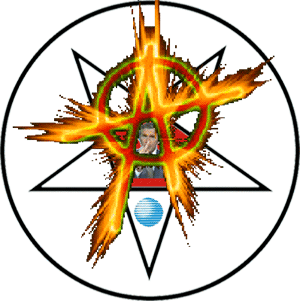
By Ryan Singel
News organizations will argue Thursday [TODAY] that documents under seal in a high-profile lawsuit against AT&T for its alleged participation in warrantless surveillance of Americans' phone calls and e-mails should be made public.
"Even if there are trade-secrets interests, that interest has to yield to the paramount public interest in what the court is deciding," Alger said. "People should know if their phones are being tapped into by AT&T on behalf of the government."
Complete Article: http://www.wired.com/news/technology/0,72336-0.html?tw=rss.index
Is Sacraficing People In Bush's Illegal War A NEOCON Bloodlust?
Experiments in Moral Sovereignty - Notes of an American Exile
by Jeff Knaebel
During October–November 2006, the writer gave presentations at workshops and seminars across India that had been convened to address the existential crises facing humanity. Sponsors and venues included Prakrit Bharati Academy and Kapil Smarak Samiti, Jaipur; Friends of Gandhi Museum, Pune; Gandhi Peace Foundation, New Delhi; and World Buddhist Cultural Foundation, Varanasi. The following introduction is the first in a short series of condensations.
These presentations across India express three main themes:
1 A call to people of the world to generate an evolutionary quantum leap into a higher consciousness of nonviolence in order that we may survive as a species. This call is for a revolution from fear to love, from greed to generosity, from cruelty to compassion, from deceit to truth, from dependence to self-reliance, from war to peace, from corporate enslavement to individual liberty.
2 An appeal to India to help raise humanity to a more sacred destiny – not as a nation state, but as a people – to guide mankind to that spiritual unity which alone can bring peace on earth.
3 The story of one man’s quest for individual moral sovereignty in a world of institutionalized structural violence imposed by the corporate warfare state. This struggle – within himself as well as with powers that be – led him to renunciation of and severance from his native land. He lives in India in self-imposed exile.
As a US citizen, he remains subject to the tyrannical power of the USA Patriot Acts and the Military Commissions Act of 2006. Publication of these seminars places the author at personal risk. He could be put on some government watch list or no-fly list. He could be jailed indefinitely, without charges and without right of habeas corpus. He dares not return to American soil.
I, Jeff Knaebel, undertake this risk as a duty to humanity and the ideals of liberty. Guided by my conscience, I openly declare repudiation of US income tax law. I do not labor for my earnings to be employed to finance bombs which shred the bodies of women and children. My purpose on this earth is not to finance destruction and murder, but to learn the practice of gratitude and reverence for all life.
Deeds are essential. All morally vigorous people express thought as action. The inner work is primary and crucial. One gains strength from introspection.
The background from which these presentations emanate – as well as the motivation for speaking – is a set of simple yet horrifying observations. In all but about twelve of my 67 years, USA has been engaged directly in foreign warfare. Within the past century, nation states have murdered at least 200 million people in wars and internal conflict. The modern corporate warfare state has wrought such vast wanton ecological and cultural destruction as to threaten survival of human species. We live under threat of an insane political theory of nuclear deterrence through mutually assured destruction.
At this moment, an American nuclear armada is standing off the coast of Iran. A nuclear attack seems easily within the realm of possibility. It will precipitate an unimaginable conflagration throughout the Middle East and West Asia, if not the whole world. For six billion human beings to have organized themselves into a structure, such that a handful of powerful men can trigger a final holocaust, is to me insane. Nuclear proliferation is expanding to include new players. The sheer scale of violence emanating from a hierarchy of power relations – fuelled by greed and the drive to dominate – is leading us to destruction.
The Corporate Warfare State is the most abominable failure of humanity in all of history.
My presentation discusses what the State really is and how it actually operates, stripped of propaganda and delusion. It points out the fatal ethical design errors of system. It shows how power structures attract the most corruptible of men: those who will to ruthless murder in order to accomplish their evil ends. At the peak of its growth cycle, the State becomes a gang of criminals ruling by a mix of force, deceit and manufactured consent.
Using Gandhi’s demonstration of means is to end as seed is to tree, it is shown how an institution based upon the fundamental moral flaw of a monopoly on violence can never lead to peace. The State is likened to a machine which has run amok – out of control. The relevant operational fact is that State-sponsored endless war is no more than a profiteering racket. War is health of State. War is profit to the big corporate money interests. Loss of life does not report to the corporate balance sheet.
The nature of power relations which create the operating dynamics of the State is examined. I conclude: For power, there is no tomorrow. There are no grandchildren. Even of earth, there is none. There is only power.
The way has been lost. We stand on the brink of a maniacal holocaust. How shall we live?
The relationship of individual to State is examined. How did it come to be? Is it a valid relationship in terms of reason, law, common sense, and conscience? I ask basic questions of the State. Does it murder? Am I financing this murder? Am I therefore responsible? Do I finance murder voluntarily? Am I therefore a slave?
Conclusion is that the constitution is of no authority. There can be no valid binding agreement among men who never met even to discuss a document which itself was drafted by men long since dead. The dead cannot bind the living. Whatever agreements they made, whatever constitutions they made, applied only to them and died with them. Thus the State which rules my life is invalid at inception.
A list of 72 violations of my human rights perpetrated by the United States is presented. It is clear that – measured by the parameters of clinical psychology – the historical "run of the mill" heads of State suffer from paranoid delusions, kleptomania, a pathological tendency to commit murder and acts of extreme violence and cruelty, an obsessive acting out of ruthless domination. Diagnosis: criminally insane.
The reader is asked to question for himself, what three behavioral traits did the following men all exhibit in common: Abraham Lincoln, Theodore Roosevelt, Woodrow Wilson, Lenin, Mussolini, Hitler, Churchill, Stalin, Franklin Roosevelt, Harry Truman, Mao Zedong, George Bush, Tony Blair? For one clue, is not the lust for power and domination quite clear? How did it manifest? Absent the institutional architecture of an all-powerful State, would it have been possible for them to have wrought so much murder?
The government has perverted justice and public morality into such grotesque forms as to be unrecognizable to a rational man with a conscience. The State is an abomination vile, corrupt, vicious, destructive and murderous. It has become the single greatest threat to human survival.
Perceiving the American state to be a criminal operation of nigh incomprehensible scale – having perpetrated innumerable heinous crimes against humanity – and having executed no contract by which it has any jurisdiction over my life, I declare my right to renounce and depart from it without obligation.
I will present for your consideration my personal Declaration of Severance and Independence from the United States. It says in part: I hold these to be self-evident truths, that all people are endowed at birth with equal, inalienable and independent rights, among which are sole possession of their own life, liberty and the seeking of happiness in their own way. That men may secure these rights by forming such associations as they choose, which must operate by non-coerced full consensus, and from which any member is free to secede.
We make a mistake to plead and litigate with our masters using only the tools they have provided us. We cannot prevail within a frame of the same rules by which we are enslaved. By this pleading, we only feed the monster with our energy and money. We must take back personal responsibility for our independence, and for our survival. One way is to exercise our natural right to ignore the State, to renounce it, and to work at building an independent life, accepting neither the State’s "benefits" nor its costs, to the extent we are able to avoid them.
Gandhi’s example of Satyagraha (strong adherence to truth) with Ahimsa (non-violence) points the method. We must be the change we wish to see. I submit that a simple first step is to tell the truth in every transaction, to every person, at all times, in every situation. When we begin to call things by their true name – for example, "collateral damage" is murder pure and simple – we will begin to wake up to the reality of the human condition created by The Powers That Be, and to which we have acquiesced for far too long.
I conclude that there is no political institution/ism, no authoritarian person/ist, no economic policy, and no government that can save us from the self-inflicted disaster bearing down upon us. Only the freedom to be in love with life, and to express that love without arbitrary institutional barriers that label us as "the other" – and thus block person-to-person natural expression – can save us. This is a freedom to live in the original unconditioned character – found deep within each of us – of total, sweeping, deep, overflowing, unconditional love of life, of this earth, of its creatures, of ourselves, of each other. To express this love, we must get the State out of our way.
May you live long, live free.
December 21, 2006
Jeff Knaebel [send him mail] is an expatriate American domiciled in India since 1995. He formerly practiced as a registered professional engineer, having been trained at Cornell Univ. and the Colorado School of Mines.
Source: http://www.lewrockwell.com/orig6/knaebel7.html - Copyright © 2006 LewRockwell.com



